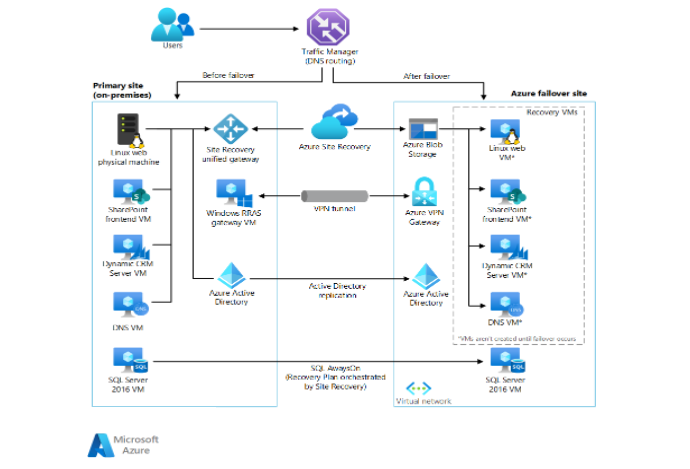- April 17, 2024
Disaster Recovery in Azure: Architecture and Best Practices
Several organizations that run critical business applications set up Azure Disaster Recovery with high availability, and do you know why?
Because of its necessity in most enterprises. Disaster Recovery in Azure is a combination of policies, and a set of tools to enable recovery and resume significant technology infrastructure, following a widespread natural or human-induced disaster.
To be precise, Microsoft’s Disaster Recovery strategy can be planned for the entire IT landscape on Azure, which means that you will have to consider non-SAP applications as well. So, for the SAP applications to run seamlessly, you will have to recover your assets or dependent services on the DR site.
Now, get to learn about Azure Disaster Recovery in detail, that we have produced in this article to highlight Microsoft Disaster Recovery’s architecture and its best practices. Procure these insights that help you in the best way to protect your data in your business.
Let’s get in!
What is Azure Site Recovery?
Azure site recovery (ASR) known as Disaster Recovery as a Service (DRaaS) offers businesses to use as a part of their business continuity and Disaster Recovery Azure program.
Azure Site Recovery adapts and automates applications in hybrid and other cloud environments. The service also replicates Azure Virtual Machines across regions, On-Premises to secondary data centers, Azure Stack VMs, and On-Premises physical servers and VMs to Azure.
Procuring Azure Disaster Recovery site was never so cheaper before, and most traditional site recovery involved equipment that protects and costs 80% of the original site.
On the other hand, Azure site recovery is charged only for the protected node and data storage and saves costs.
Two Solution Architectures of Azure Disaster Recovery
SMB Disaster Recovery in Azure
For small businesses, implementing Disaster Recovery in the Cloud at low cost makes it a feasible task utilizing partner solutions like Double Take DR based on Traffic Manager, Azure site recovery, and Azure Virtual Network services that operate in a supportive, patched, and highly available environment.
The solution architecture is defined below:
- Traffic Manager: They route the DNS traffic that moves between the sites based on your business policies.
- Azure Site Recovery: It organizes and orchestrates machine replication and manages failback procedures' configurations.
- Virtual Network: It is the location of the failover site created during the disaster.
- Blob Storage: It allows businesses to store replica images of the Site Recovery-Protected Machines.
Enterprise-scale Disaster Recovery in Azure
When it comes to large organizations, they will have to build Azure Disaster Recovery capabilities, especially for the systems like SharePoint, Dynamics CRM (Customer Relationship Management), Linux, and web servers in On-Premises datacenter.
Microsoft Azure Disaster Recovery provides innovative solutions to avoid failover of a complex environment to Azure infrastructure. The solution depends on Traffic Manager, Site Recovery, Virtual Network, Azure Active Directory, and VPN Gateway. Azure database migration becomes successful with proactive disaster recovery plans.
Note that these services can run in high-availability environments supported and patched by Azure. The solution architecture is defined below:
Azure Disaster Recovery Best Practices
The initial step to produce Azure Disaster Recovery plan includes complete testing, and implementation by verifying its effectiveness. It is important to include relevant technologies and processes required to restore functionality within your service-level agreement (SLA).
A Few tips to create and test your Azure Disaster Recovery Plan:
1) Azure Disaster Recovery Plan
- Evaluation: Prior to plan creation, business groups will have to evaluate the impact of application failure and data loss to build your recovery plan around the most critical applications and data. Specify a role for someone who can own the Disaster Recovery Plan, and oversee all aspects, including testing and automation.
- Support: Precisely define the process for contacting your support services and instructions for escalating issues as this documentation will aid in preventing prolonged downtime and utilize cross-regions for your mission-critical applications.
- Automate: Your automated plan must include a backup strategy that covers all transactional and reference data. It’s also vital to do the backup restoration process regularly, and document the processes including manual steps, and automated tasks.
- Monitor: Regular monitorization and alerts must be configured for all the Azure services that are consumed by applications. Train your executives and execute the plan to perform regular disaster recovery simulations to verify and improve your plan.
2) Operational Readiness Testing
Testing your Disaster Recovery plan before implementation can help decrease risks and verify its effectiveness. These operational readiness tests must be followed before implementation, and they include:
- Failback to the primary region
- Failover to a secondary region
Failback and failover tests enable to verify application’s dependent services that remain synchronized when restored during the disaster recovery process. It is also harder to determine the impact of changes to operations and systems on failback and failover functions. These tests can help you avoid problems in real scenarios.
Azure also supports manual failover for various services and at times offers failover tests for disaster recovery drills. One can also simulate an outage by removing or shutting down Azure services and you can also set up automated testing for operational responses to ensure operational effectiveness.
- Traffic Manager: They route the DNS traffic that moves between the sites based on your business policies.
- Azure Site Recovery: It organizes and orchestrates machine replication and manages failback procedures' configurations.
- Virtual Network: It is the location of the failover site created during the disaster.
- Blob Storage: It allows businesses to store replica images of the Site Recovery-Protected Machines.
3) Dependent Service Outage
Security Optimization Assessments and determining implications of disruptions in each service must be monitored to ensure how these applications respond to the disruptions. Azure services support features with availability and resiliency by evaluating each service independently and strengthening the Disaster Recovery Plan in Azure.
4) Network Outage
The Disaster Recovery Plan must define processes for network outage events. When parts of the network are inaccessible, it might prevent you from applications or data access. The way you can respond to this issue is by running most applications with reduced functionality. In case you cannot reduce functionality, then try failing over to another region to avoid application downtime.
5) Plan For Regional Failures
Azure has two divisions, logically and physically into units called regions. Each region includes one or more data centers, and most support availability zones offer more resiliency during outages. One can also use Azure regions to improve application’s availability.
Azure has two divisions, logically and physically into units called regions. Each region includes one or more data centers, and most support availability zones offer more resiliency during outages. One can also use Azure regions to improve application’s availability.

Microsoft Azure Business Continuity Plan
Microsoft Azure cloud migration and modernization services involve four aspects of business continuity plans.
- Assessment: Start assessing the business functions in your organization to support your services and processes. It might include accomplishing a business impact analysis that is ranked depending on the identification or assessment of the processes and services.
- Planning: Plan for outcomes by prioritizing resilient strategies, and On-premises Microsoft Azure Service Map helps businesses in mapping and automatically identifies application components on various Linux systems and Windows that start mapping TCP dependencies, discover connections.
- Capability Validation: Right after mapping out processes and technologies, validate your business processes’ continuity plans. It is absolutely vital to not forget regulatory training on continuity measures for employees.
- Communication & Coordination: Microsoft Azure cloud service maintains communication channels with security and compliance that are used prior to disruption. Each team has internal communication channels to utilize and coordinate when the normal communication channels do not work.
Built-In Data Protection for Disaster Recovery with HexaCorp
HexaCorp provides you with an assigned setting with a disaster recovery strategy deploying On-premises to Azure cloud services. Prevent Costly business interruption with integrated on-premises data backup solutions.
Retrieve your data with simple & secure recovery solutions. Utilize Azure managed services to circumvent data loss. Get your instant backup recovery with our DR services.
Forget data loss & regain access & functionality to IT infrastructure after disasters from cyber-attack or business disruptions. Microsoft Azure Cloud Services offers end-to-end backup & disaster recovery to enhance business continuity strategy.
Conclusion
Disaster Recovery is crucial for every business, and to set it right with much-optimized costs, choose Azure Disaster Recovery plans to protect your business from surprise data loss. May it be a human error or a disaster, Azure’s restored data will have you packed up at any time with phenomenal applications and plans.
For more information, visit www.hexacorp.com




